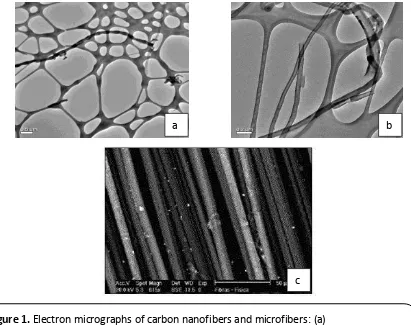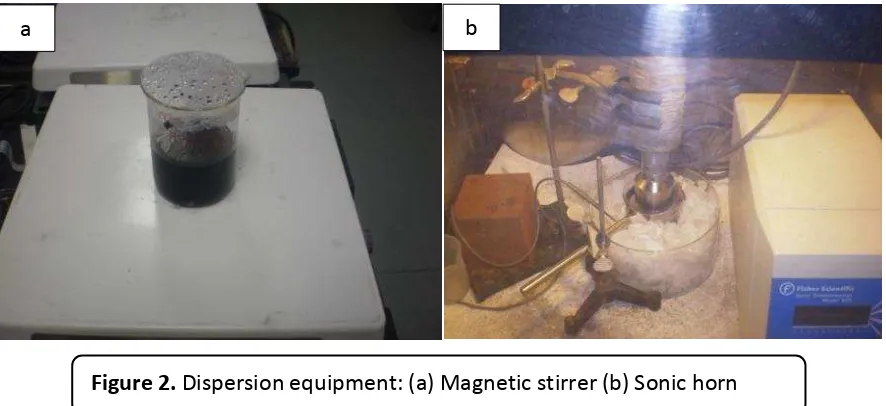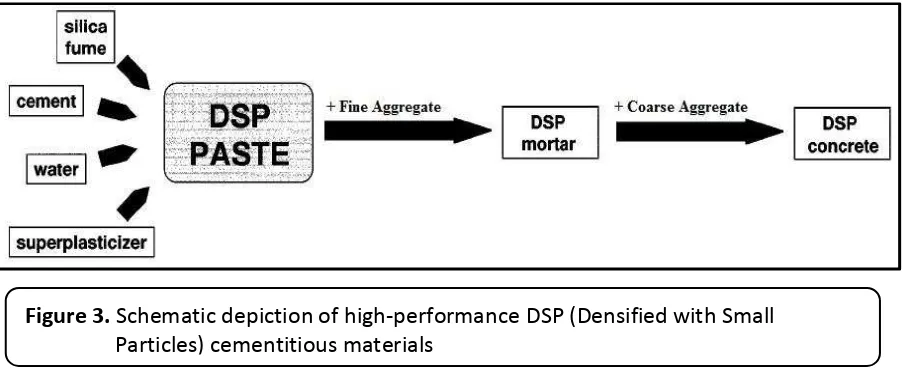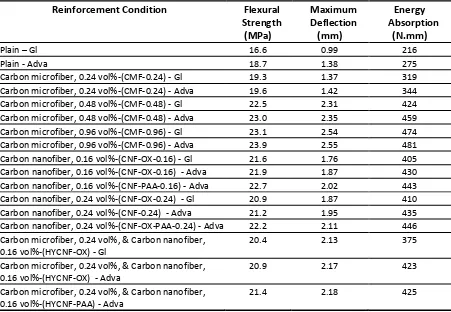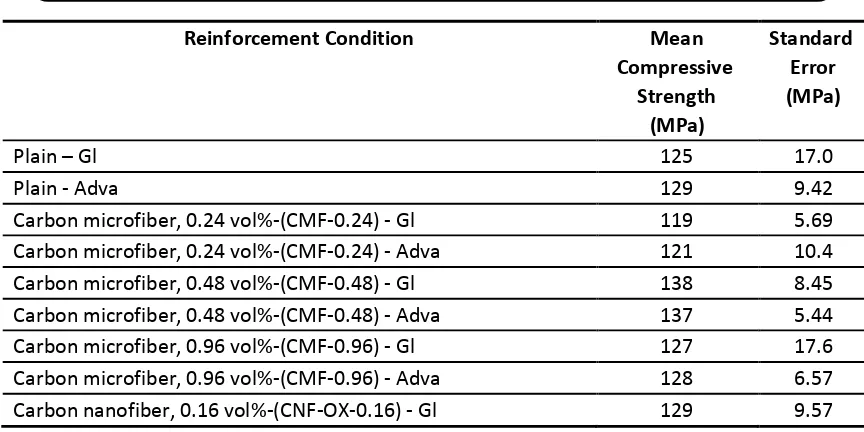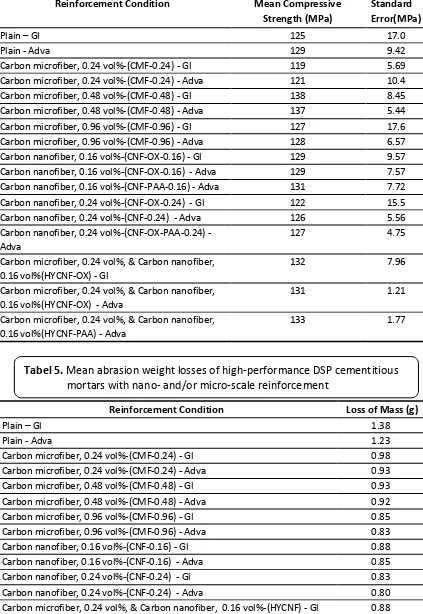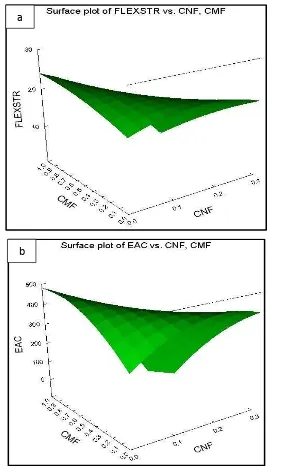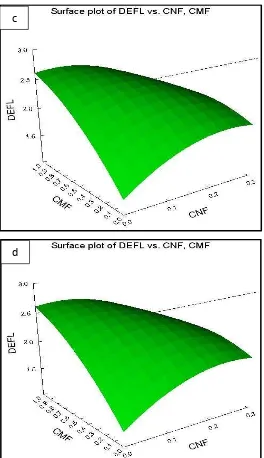Muhammad Maqbool Sadiq Awan et.al.USE OF CARBON NANO-FIBERS IN CEMENTITIO... | 134
Use of Carbon Nano-Fibers in Cementitious Mortar
Muhammad Maqbool Sadiq Awan1, Parviz Soroushian2, Arshad Ali1*, Muhammad Yousaf Saqid Awan1
1CE Wing, Millitary College of Engineering, National University of Sciences and Technology, Islamabad 44000,
Pakistan
2Department of Civil and Environmental Engineering, Michigan State University, Engineering Building 428 S.
Shaw Lane, Room 3546 East Lansing, MI 48824, US
* Correspondence: aliarshad08@yahoo.com
A B S T R A C T S A R T I C L E I N F O
Cementitious materials, especially those with higher compressive strengths, provide relatively low toughness, tensile strength and strain capacity, and are susceptible to cracking under load and restrained shrinkage effects. These drawbacks were overcome through development of multi-scale reinforcement systems comprising carbon nanofibers and microfibers for high-strength cementitious mortars. Multi-scale reinforcement of the high-performance mortar produced significant gains in the flexural strength and toughness, and abrasion and impact resistance. Microstructural investigations were also conducted in order to provide insight into the structure and failure mechanisms of high-performance cementitious mortars with multi-scale reinforcement.
© 2017 Tim Pengembang Journal UPI
Article History: Received 03 May 2017 Revised 31 May 2017 Accepted 16 Jun 2017 Available online 01 Sep 2017
____________________ Keyword:
High-Performance Cementitious Materials,
Multi-Scale Reinforcement, Carbon Nanofibers and Microfibers.
Indonesian Journal of Science & Technology
1. INTRODUCTION
Fibers are incorporated into cementitious matrices to enhance their toughness, tensile strength and ductility, and crack resistance. Cracks initiate in hand, could limit the concentration and size
of su h i ro ra ks , a d their
propagation in cementitious materials. Thorough dispersion and effective interfacial interactions of nanofibers are critical to their effectiveness in cementitious materials. The relatively short length of nanofibers, however, limit their ability to bridge across wider crackes, and provide for substantial energy dissipation via extended frictional pullout. Longer micro-scale fibers can complement the action of nanofibers at fine scale with crack control and toughening effects at advanced stages of damage development. Background work on use of nano-scale (primarily multi-walled carbon nanotubes) reinforcement of high-performance cementitious materials have indicated that major gains in engineering properties of cementitious materials can be realized with relative low dosages (as small as 0.04% by weight of cement) (Sadiq et al, 2012a ; Sadiq et al, 2012b ; Sadiq et al, 2012c).
One objective of the work reported herein was to assess the effectiveness of carbon nanofibers as relatively low-cost nano-scale reinforcement in high-performance cementitious mortars. The other objective was to validate the synergic action of a multi-scale reinforcement comprising carbon nanofibers and microfibers as reinforcement in high-performance cementitious mortars.
Carbon nanofibers (CNFs) are made of grapheme sheets formed into cones, which are stacked to assume a tubular geometry with 50-200 nm outer diameter. The elastic modulus of individual nanofibers ranges from 25 to 200 GPa, depending on their diameter (Lawrence et al, 2008). Given their relatively low cost compared to carbon nanotubes, development of carbon nanofiber reinforced polymer nanocomposites is actively pursued (Shofner et al., 2003; Hammel et al., 2004; Lafdi et al., 2008). Efforts to assess the value of carbon nanofibers to inorganic (including cementitious) matrices have also been initiated; uniform dispersion and effective interfacial interactions are key to their reinforcement efficiency in cementitious materials(Sadiq et al, 2012a ; Sadiq et al, 2012b ; Sadiq et al, 2012c; Xie
et al., 2005). Past experimental evaluations of the reinforcement efficiency of carbon nanofibers in cementitious matrices have yielded mixed results, which could be partly attributed to the extent of dispersion and interfacial interactions of nanofibers in cementitious materials, and also to the qualities (e.g., density, pore system characteristics and strength) of the cementitiou matrix. In a series of tests, the introduction of silica fume (with nano-scale particle size) to cement (with micro-scale particle size) as well as acid treatment of nanoifbers were found to benefit dispersion of carbon nanofibers in cementitious matrices; the addition of nanofibers at 0.005% to 2% by weight of cement, however, did not benefit the mechanical properties of cementitious materials (Sanchez and Ince, 2009; Sanchez
DOI: http://dx.doi.org/10.17509/ijost.v2i2 p- ISSN 2528-1410 e- ISSN 2527-8045
in the flexural strength of cementitious materials realized by introduction of carbon nanofibers at 0.048 wt%. Scanning electron microscope images showed that carbon nanofibers bridge across fine cracks, and control their propagation.
In this study, the gains in reinforcement efficiency of carbon nanofibers, alone or in combination with carbon microfibers, resulting from oxidation of nanofibers and also the use of refined methods for dispersion of nanofibers were investigated. A highperformance cementitious matrix (densified with small particles –DSP) was considered here, and different nanofiber volume fractions were evaluated. Two
alternative polycarboxylate-based super-plasticizers were used for preparation of cementitious matrices. One of these superplasticizers, which performed better in cementitious nanocomposites, was used throughout the investigation.
2. MATERIALS AND METHODS 2.1 Materials
Carbon nanofibers, Figure1 were 60 to
i dia eter, to μ i le gth.
These carbon nanofibers provided 50 to 60 m2/g specific surface area of, ~1.95 g/cm3 true density, and purity of >95%. They were purchased in either prestice (CNF) form or in oxidized (acid-functionalized) condition (CNF-OX) from Pyrograf Products, Inc.
Figure 1. Electron micrographs of carbon nanofibers and microfibers: (a)
Nonfunctionalized Nanofibers with 60-150 nm outer diameter and lengths up to 100 µm; (b) Oxidized Nanofibers with 60-150 nm outer diameter and lengths up to 100 µm ; (c) SEM micrograph of carbon microfibers (TT 143) with 6 mm length
a b
Carbon microfiber (TT 143) with 6 mm
le gth a d to μ dia eter as o tai ed
from Toho Tenax America, Inc. Poly(acrylic acid) (PAA, average Mw of ~100,000; 35 wt% in H2O) was purchased from Sigma-Aldrich. Deionized (DI) water was used for preparation of all solutions.
The materials selected for use in cement-based matrix included Type I Portland cement (Lafarge-North America), undensified silica fume (Norchem, Inc.) with 200 nm average particle size, two silica sands (Fairmount Minerals) with average particle
sizes of a out 9 a d μ , o prisi g
>99.5% silica, and two ASTM C 494 Type F polycarboxylate-based superplasticizers: Glenium® 7700 and ADVA® Cast 575 obtained from BASF and W. R. Grace, respectively.
2.2 Dispersion of Nanotubes in Water
The steps involved in dispersion of carbon nanofibers (CNFs) are described in the following:
(1) Add the required amounts of oxidized nanofibers to the mixing water. In cases where PAA-physisorbed carbon nanofibers were considered, carbon nanofibers and poly acrylic acid (PAA)
were added to the mixing water at 1:1 weight ratio. Physisorption of PAA on carbon nanofibers was considered as an approach to improving the dispersion and interfacial interactions of nanofibers in cementitious matrices.
(2) Stir the mix overnight (12 to 15 hours) using a magnetic stirrer, Figure2(a). (3) Sonicate the mix using a probe as
follows, Figure 2(b): (i) Sonicate for ten minutes at different amplitudes (30, 45, 65 and 75%) with 1-minute breaks between different amplitudes; (ii) Pulse (1 minute on & 30 seconds off) for 10 minutes at 85% amplitude; (iii) Turn off the sonic probe for 2 minutes, and repeat the pulsing cycle two more times; and (iv) Repeat the whole sonic probing cycle one more time.
(4) For reinforcement conditions comprising either microfibers or both microfibers and nanofibers, microfibers were added to the mixing water without using the above dispersion procedure. Microfibers were added to the mixing water half an hour before mixing it with other ingredients of the highperformance cementitious matrix.
Figure 2. Dispersion equipment: (a) Magnetic stirrer (b) Sonic horn
DOI: http://dx.doi.org/10.17509/ijost.v2i2 p- ISSN 2528-1410 e- ISSN 2527-8045
2.3 Cementitious Matrix
Dense cement-based matrices with a smooth particle size gradation covering the nano- to micro-scale range were used to ensure effective interfacial interactions which help mobilize the tremendous mechanical qualities of carbon nanofibers within cementitious nanocomposites. The high-performance cement-based matrix used here is generally referred to as DSP (Densified with Small Particles). DSP cement-based materials comprise micro-scale cement and nano-scale silica fume particles, dispersed and densified using superplasticizer Figure 3 (Guerrini G.L., 2000). This cementitious matrix, when used with other high-quality ingredients (e.g., high-quality aggregates and discrete reinforcement) can yield highly desired combinations of mechanical properties and durability suiting demanding fields of application (Guerrini G.L., 2000). The microstructure and thus engineering properties of high-performance (DSP) cementitious materials can be improved by steam or high-pressure steam curing, which
benefit pozzolanic reactions. Based on a review of the literature on DSP high-performance cementitious materials (Guerrini G.L., 2000; Shannag M.J., et al., 1991; Sun G.K. and Young J.F., 1993; Tjiptobroto P. and Hansen W., 1993; Sun G.-k. and Young J.F., 1993; Tjiptobroto P. and Hansen, 1993; Beaudoin J.J., et al., 1994; Richard P. and Cheyrezy M., 1995; Cheyrezy M. et al., 1995; Shannag M.J. et al., 1996; Young J.F., 1996; Roux N. et al., 1996; Zanni H., et al.,1996; Feylessoufi A.
et al.,1996; Shannag M.J. et al., 1997; Hu A., et al.,1999; Shannag M., et al., 1999; Zivica V., 1999; Matte V. and Moranville M., 1999; Shannag M.J. and Hansen W., 2000; Camilleri J., et al.,2001; Moranville-Regourd M., 2001; Collepardi M., et al., 2002; Morin V., et al.,2002; Badanoiu A. et al., 2003; Bayard O. and Pie O., 2003; Chan Y.-W. and Chu S.-H., 2004; Washer G. et al., 2004; Childs P., et al., 2007; Lee M.-G. et al., 2007; Wong A.C.L. et al.,2007), the cementitious mortar introduced in Table 1 was selected for evaluation of the merits of oxidized carbon nanofibers in cement-based matrices.
Ingredient DSP Mortar
Silica Fume/Binder 0.20
Water/Binder 0.20
Superplasticizer/Binder Adjusted for diff reinf Silica Sand (0 – 0.18 mm) / Binder 0.36
Silica Sand (0.18 -0.6 mm) / Binder 0.86
Cementitious materials (with and without carbon nanofibers and/or microfibers) were prepared following the procedures outlined in ASTM C 192 and C 305. Specimens were moist-cured inside molds after casting (ASTM C 192) over a 24-hour period, and were then demolded and subjected to 48 hours of steam curing at 70oC. The samples were subsequently conditioned at 50% relative humidity for seven days prior to testing. At least two batches were prepared for each mix, and at least four specimens were prepared form each batch for performance of tests on each engineering property.
2.4 Experimental Methods
The test procedures employed to determine the engineering properties of cementbased materials are described in this section. Compression tests (ASTM C 109) were performed on 50 mm cube specimens. Flexure tests (ASTM C 1185) were performed on 12.5 x 50 x 150 mm specimens by center-point loading on a span of 125 mm using a deflection-controlled mechanical test system, with load and deflection data collected using a data acquisition system. Impact tests (ASTM D 7136) were performed on 12 x 150 x150 mm specimens. Abrasion tests (ASTM C 944) were conducted on the surface of cylindrical specimens with 100 mm diameter (and 50 mm height).
The following experimental methods were also employed to gain further insight into the structure and failure mechanisms of cement-based nanocomposites: (i) scanning electron microscopy (SEM); and (ii) Energy Dispersive Spectroscopy (EDS). Experimental results were evaluated using the analysis of variance (ANOVA) and pair-wise comparison techniques. Response Surface Analysis (RSA) was used to identify reinforcement volume fractions which yield optimum gains in various engineering properties of the cementitious matrix.
3. RESULTS AND DISCUSSION
3.1 Effects of Carbon Nano- and/or Micro-fibers Used at Different Volume Fraction and with Different Super-plasticizers
3.1.1 Flexural Performance
The flexural characteristics of high-performance cementitious mortar were assessed following ASTM C293 (Standard Test Method for Flexural Strength of Concrete - Simple Beam with Center-Point Loading), using 150 mm x 50 mm x 12.5 mm rectangular specimens. The flexural strength, maximum deflection and energy absorption capacity (area underneath the flexural load-deflection curves) were determined for the high-performance (DSP) cementitious mortar reinforced with different volume fractions of oxidized or PAA-physisorbed carbon
DOI: http://dx.doi.org/10.17509/ijost.v2i2 p- ISSN 2528-1410 e- ISSN 2527-8045
nanofibers and/or microfibers, prepared using two different carboxylate-based superplasticizers. The flexure test data are summarized in Table 2. The experimental results indicate that all reinforcement conditions considered here produced improvements in the flexural attributes of high-performance cementitious mortar. Maximum improvements were realized with PAA-physisorbed carbon nanofiber (CNF-PAA) and its hybrid combination with carbon microfibers. The maximum gain in flexural strength versus plain mortar (21.4%) was achieved at 0.16 vol% CNF-PAA, which was 4.3% greater than that achieved with a similar volume fraction of carbon nanofibers used without polymer wrapping. It should be noted that the volume fraction of carbon nanofibers is calculated here with respect to the volume of dry cementitious materials (cement and silica fume). The maximum
improvements in energy absorption capacity and maximum deflection versus plain mortar (62.2 and 52.9%, respectively) were realized with 0.24 vol% CNF-PAA. The gains in these flexural attributes were also higher with polymer-wrapped carbon nanofibers (CNF-PAA) when compared with carbon nanofibers used without polymer wrapping. Hybrid reinforcement systems comprising both nano-scale CNF-PAA and micro-nano-scale carbon fibers brought about balanced improvements in the engineering properties of high-performance cementitious mortars, which surpassed those achieved with nano- or micro-scale reinforcement used alone. Polymer wrapping of carbon nanofibers consistently improved the reinforcement efficiency of nanofibers in high-performance (DSP) mortar. ADVA® Cast 575 polycarboxylate-based superplasticizer produced better results when compared with Glenium® 7700. Carbon microfiber, 0.24 vol%, & Carbon nanofiber,
0.16 vol%-(HYCNF-OX) - Gl
20.4 2.13 375
Carbon microfiber, 0.24 vol%, & Carbon nanofiber, 0.16 vol%-(HYCNF-OX) - Adva
20.9 2.17 423
Carbon microfiber, 0.24 vol%, & Carbon nanofiber, 0.16 vol%-(HYCNF-PAA) - Adva
21.4 2.18 425
Per-unit volume fraction, carbon nanofiber was more effective than carbon microfiber in enhancing the flexural performance characteristics of DSP cementitious mortar. Hybrid (nano- and micro-scale) reinforcement systems comprising 0.16 vol% of CNFPAA and 0.24 vol% of CMF produced highly desired, balanced gains in the flexural performance characteristics of high-performance DSP cementitious mortar at a relatively low total reinforcement volume fraction.
Analysis of variance of test results indicated that the reinforcement conditions considered here produced statistically significant (at significance level of 0.05) improvements in all flexural attributes of the high-perofrance cementitious mortar. Subsequent pair-wise comparisons of test results indicated that all nano- and/or micro-scale reinforcement conditions produced statistically significant gains (at significance levelof 0.05) in the flexural performance characteristics of the high
performance (densified with small particles – DSP) mortar. Distinct improvements (at 0.000 significnace level) in all flexural attributes were realized with the addition of CNFPAA and/or CMF reinforcement.
3.1.2 Compressive Strength
The compressive strength test results (mean values and standard errors) for highperformance cementitious mortars with nano- and/or micro-scale reinforcement systems are presented in Table 3. PAA- physisorbed as well as oxidized or pristine carbon nanofibers, when used alone or in combination with carbon microfibers produced statistically insignificant effects on the compressive strength of the highperformance cementitious mortar (significance level of 0.759). Pair-wise comparisons indicated that the difference between no pair of compressive strength test results was statistically significant (at significance level of 0.05).
DOI: http://dx.doi.org/10.17509/ijost.v2i2 p- ISSN 2528-1410 e- ISSN 2527-8045
Reinforcement Condition Mean
Carbon nanofiber, 0.24 vol%-(CNF-OX-PAA-0.24) - Adva 127 4.75 Carbon microfiber, 0.24 vol%, & Carbon nanofiber, 0.16
vol%(HYCNF-OX) - Gl
132 7.96
Carbon microfiber, 0.24 vol%, & Carbon nanofiber, 0.16 vol%(HYCNF-OX) - Adva
131 1.21
Carbon microfiber, 0.24 vol%, & Carbon nanofiber, 0.16 vol%(HYCNF-PAA) - Adva
133 1.77
3.1.3 Impact Resistance
The impact test data are summarized in
Table 4. Nanofiber reinforcement at 0.24 vol% as well as hybrid reinforcement of DSP mortar produced more than 50% gain in impact resistance. At equal volume fractions, nanofibers were more effective than microfibers in enhancing the impact resistance of the high-performance cemen-titious mortar with both superplasticizers. The hybrid (nano- and micro-scale) reinforcement was more effective than micro-scale reinforcement alone in improving the impact resistance of DSP mortar. The analysis of variance and pair-wise comparisons of impact test results indicated that the gains in impact resistance with nano- and/or micro-scale reinforcement of DSP mortar were statistically significant (at 0.05 significance level).
3.1.4 Abrasion Resistance
The abrasion test results for DSP mortars with different volume fractions of carbon nanofiber and/or microfiber reinforcement are summarized in Table 5.
With ADVA® Cast 575 superplasticizer, carbon nanofiber (0.24 vol%) and its hybrid combination with carbon microfiber produced the greatest improvement (34.7%) in the abrasion resistance of DSP mortar. Nano- and/or micro-scale reinforcement of DSP mortar produced marked improvements in abrasion resistance, which were statistically significant at 0.05 significance level. Outcomes of pair-wise comparisons confirmed that each of the reinforcement conditions considered here produced statistically significant gains in the abrasion resistance of the DSP cementitious mortar.
Tabel 3. Mean values and standard errors of the compressive strength test results for DSP mortar with nano- and/or micro-scale reinforcement systems (continue)
Reinforcement Condition Mean Compressive Strength (MPa)
Standard Error(MPa)
Plain – Gl 125 17.0
Plain - Adva 129 9.42
Carbon microfiber, 0.24 vol%-(CMF-0.24) - Gl 119 5.69 Carbon microfiber, 0.24 vol%-(CMF-0.24) - Adva 121 10.4 Carbon microfiber, 0.48 vol%-(CMF-0.48) - Gl 138 8.45 Carbon microfiber, 0.48 vol%-(CMF-0.48) - Adva 137 5.44 Carbon microfiber, 0.96 vol%-(CMF-0.96) - Gl 127 17.6 Carbon microfiber, 0.96 vol%-(CMF-0.96) - Adva 128 6.57 Carbon nanofiber, 0.16 vol%-(CNF-OX-0.16) - Gl 129 9.57 Carbon nanofiber, 0.16 vol%-(CNF-OX-0.16) - Adva 129 7.57 Carbon nanofiber, 0.16 vol%-(CNF-PAA-0.16) - Adva 131 7.72 Carbon nanofiber, 0.24 vol%-(CNF-OX-0.24) - Gl 122 15.5 Carbon nanofiber, 0.24 vol%-(CNF-0.24) - Adva 126 5.56 Carbon nanofiber, 0.24 vol%-(CNF-OX-PAA-0.24) -
Adva
127 4.75
Carbon microfiber, 0.24 vol%, & Carbon nanofiber, 0.16 vol%(HYCNF-OX) - Gl
132 7.96
Carbon microfiber, 0.24 vol%, & Carbon nanofiber, 0.16 vol%(HYCNF-OX) - Adva
131 1.21
Carbon microfiber, 0.24 vol%, & Carbon nanofiber, 0.16 vol%(HYCNF-PAA) - Adva
133 1.77
Reinforcement Condition Loss of Mass (g)
Plain – Gl 1.38
Plain - Adva 1.23
Carbon microfiber, 0.24 vol%-(CMF-0.24) - Gl 0.98 Carbon microfiber, 0.24 vol%-(CMF-0.24) - Adva 0.93 Carbon microfiber, 0.48 vol%-(CMF-0.48) - Gl 0.93 Carbon microfiber, 0.48 vol%-(CMF-0.48) - Adva 0.92 Carbon microfiber, 0.96 vol%-(CMF-0.96) - Gl 0.85 Carbon microfiber, 0.96 vol%-(CMF-0.96) - Adva 0.83 Carbon nanofiber, 0.16 vol%-(CNF-0.16) - Gl 0.88 Carbon nanofiber, 0.16 vol%-(CNF-0.16) - Adva 0.85 Carbon nanofiber, 0.24 vol%-(CNF-0.24) - Gl 0.83 Carbon nanofiber, 0.24 vol%-(CNF-0.24) - Adva 0.80 Carbon microfiber, 0.24 vol%, & Carbon nanofiber, 0.16 vol%-(HYCNF) - Gl 0.88 Carbon microfiber, 0.24 vol%, & Carbon nanofiber, 0.16 vol%-(HYCNF) - Adva 0.80
3.1.5 Scanning Electron Microscope Eva-luations
The failed surfaces of flexure and compression test specimens were
DOI: http://dx.doi.org/10.17509/ijost.v2i2 p- ISSN 2528-1410 e- ISSN 2527-8045
evaluated under a high-precision scanning electron microscope (JOEL JM-6300F). All specimens were coated with Osmium (Using Osmium Coater Neoc-AN, Meiwa Shoji) prior to SEM observations. The SEM images presented in Figure 4 indicate that the refined sonication and mixing steps developed in the project were successful in dispersion of individual nanofibers within the cementitious matrix. These images also point at the low porosity of the high-performance cement-based matrix; the introduction of nanofibers does not seem to have compromised the high density (low porosity) of this matrix. SEM observations also provided evidence for the crack suppression and crack bridging actions of the nanofibers in cementitious matrix. PAA-physisorbed nanofibers, which provided higher levels of reinforcement efficiency, were found to produce a more uniform dispersion within the cementitious matrix, as some clumping was found for pristine nanofibers, Figure 5.
3.1.6 Energy-Dispersive Spectroscopy (EDS)
Elemental analyses were performed on 2.54 x 12 x 12 mm samples of high-performance cementitious mortar with different volume fractions of carbon nanofibers and/or carbon microfibers. The specimens were coated with carbon (using Carbon String Evaporator, Ernest F. Fullam) to make them more conductive for the purpose of EDS analysis. Elemental and Quantitative analysis of these samples indicated that all cementitious materials exhibit similar elemental compositions, except for the (expected) higher carbon content in materials incorporating carbon reinforcement. These results indicate that graphite nanomaterials do not significantly alter the chemistry of cement hydration for the reinforcement conditions considered here.
Figure 4. Typical SEM images of high-performance cementitious mortar reinforced with different contents of polymer-wrapped or acid- functionalized carbon nanofibers: (a) uniform distribution of nanofibers in the matrix; (b) and (c) microcrack bridging action of nanofibers.
Figure 5. Typical SEM mages of DSP cementitious materials reinforced with carbon nanofibers and/or carbon microfibers: (a) polymer-wrapped carbon
nanofibers within cementitious matrix; and (b) failure mechanism of micro-scale fibers at a fracture surface.
a b
a
DOI: http://dx.doi.org/10.17509/ijost.v2i2 p- ISSN 2528-1410 e- ISSN 2527-8045
3.2 Refined Hybrid Reinforcement for High-Performance Cementitious Mortar
The test data on high-performance cementitious mortar with nano- and/or micro-scale reinforcement systems prepared with two different superplasticizers were
subjected to response surface analysis. The objective of this analysis was to identify optimum reinforcement conditions which maximize: (i) benefits to specific engineering properties of the high-performance mortar; and (ii) simultaneous benefits to several engineering properties.
Figure 6. Surface plots for flexural attributes and impact resistance test data on highperformance cementitious mortar with nano- and/or micro-scale reinforcement. (a) Flexural Strength; (b) Energy Absorption Capacity; (c) Flexural Strength and (d) Impact Resistance.
c
Response surface analysis (RSA) of the test data was conducted considering the volume fractions of nano- and micro-scale reinforcement systems as input variables. Flexural strength, energy absorption capacity and maximum deflection, and impact resistance were used as response variables. The RSA process started with evaluating the effects of input variables on response variables, and was followed by desirability analyses considering means of response variables, using both canonical and ridge analysis methods.
Response Surface analyses conducted for each of the flexural strength, energy absorption capacity, maximum deflection and impact resistance test data indicated that an optimum reinforcement system comprising 0.09-0.13 vol% PaAA-physisorbed carbon nanofiber and 0.21-0.23 vol% carbon microfiber maximized subject properties. Optimal Responses for flexural strength, energy absorption and maximum deflection were calculated at 21.6 MPa, 429 N.mm and 2.61. mm mean values, respectively, with 95% confidence Interval of 20.4-22.8 MPa, 390-467 N.mm and 1.67–3.56 mm, respectively. and Optimal Response for impact resistance was calculated at 0.945 mm/mm mean value with 95% Confidence Interval of 0.767-1.12 mm/mm. All stationary points were found to be saddle points, which do not give a maximum but a general direction to follow in which the targeted properties can be maximized, Figure 6. Outcomes of ridge analysis can be used to adjust the reinforcement condition for achieving further gains in engineering properties. The analyses for flexural attributes and impact resistance show that the hybrid reinforcement systems considered here occur within the range of optimal reinforcement conditions.
The test data were also subjected to desirability analyses in order to identify reinforcement conditions which yield a desired balance of all the engineering
properties considered here. Desirability analyses were conducted using mean values obtained through both canonical and ridge analyses. These outputs indicate that maximum values of all response variables can be achieved with CNT-PAA/CMF volume fractions 0.13/0.22 or 0.15/0.26 vol% (calculated with respect to the volume of dry cementitious materials). These optimum reinforcement systems do not differ significantly from those considered in this investigation.
4. CONCLUSIONS
DOI: http://dx.doi.org/10.17509/ijost.v2i2 p- ISSN 2528-1410 e- ISSN 2527-8045
Experimental results also pointed at the merits of hybrid (nano- and micro-scale) reinforcement towards achieving balanced gains in the flexural performance characteristics and impact resistance of high-performance cementitious materials. Response surface analysis of experimental results indicated that optimum reinforcement conditions comprised both nano- and micro-scale reinforcement systems. The reinforcement conditions considered here produced minor (and statistically insignificant) changes in the compressive strength of high-performance cementitious materials.
5. ACKNOWLEDGEMENTS
This project was sponsored by the National Science Foundation Grant # IIP-1142455. The authors are thankful to Norchem, Inc and BASF Construction Chemicals for contributing materials for use in the project.
6. AUTHORS’ NOTE
The author(s) declare(s) that there is no conflict of interest regarding the publication of this article. Authors confirmed that the data and the paper are free of plagiarism.
7. REFERENCE
Anshar, A. M., Taba, P., & Raya, I. (2016). Kinetic and Thermodynamics Studies the Adsorption of Phenol on Activated Carbon from Rice Husk Activated by ZnCl2. Indonesian Journal of Science and Technology, 1(1), 47-60.
Awan, M. M. S., Soroushian, P., Ali, A., & Awan, M. Y. S. (2017). High-Performance Cementitious Matrix using Carbon Nanofibers. Indonesian Journal of Science and Technology, 2(1), 57-75.
Badanoiu, A., Georgescu, M., & Puri, A. (2003). The study of'DSP'binding systems by thermogravimetry and differential thermal analysis. Journal of thermal analysis and calorimetry, 74(1), 65-75.
Bayard, O., & Plé, O. (2003). Fracture mechanics of reactive powder concrete: material modelling and experimental investigations. Engineering Fracture Mechanics, 70(7), 839-851.
Beaudoin, J. J., Feldman, R. F., & Tumidajski, P. J. (1994). Pore structure of hardened Portland cement pastes and its influence on properties. Advanced Cement Based Materials, 1(5), 224-236.
Camilleri, J., Montesin, F. E., Curtis, R. V., & Ford, T. R. P. (2006). Characterization of Portland cement for use as a dental restorative material. Dental Materials, 22(6), 569-575. Chan, Y. W., & Chu, S. H. (2004). Effect of silica fume on steel fiber bond characteristics in
reactive powder concrete. Cement and Concrete Research, 34(7), 1167-1172.
Cheyrezy, M., Maret, V., & Frouin, L. (1995). Microstructural analysis of RPC (reactive powder concrete). Cement and Concrete Research, 25(7), 1491-1500.
Collepardi, M., Corinaldesi, V., Monosi, S., & Moriconi, G. (2002). DSP materials applications and development progress. Industria Italiana del Cemento, 540-545.
Feylessoufi, A., Villieras, F., Michot, L. J., De Donato, P., Cases, J. M., & Richard, P. (1996). Water environment and nanostructural network in a reactive powder concrete. Cement and concrete composites, 18(1), 23-29.
Guerrini, G. L. (2000). Applications of high-performance fiber-reinforced cement-based composites. Applied Composite Materials, 7(2-3), 195-207.
Hammel, E., Tang, X., Trampert, M., Schmitt, T., Mauthner, K., Eder, A., & Pötschke, P. (2004). Carbon nanofibers for composite applications. Carbon, 42(5), 1153-1158.
Hu, A., Fang, Y., Young, J. F., & Oh, Y. J. (1999). Humidity dependence of apparent dielectric constant for DSP cement materials at high frequencies. Journal of the American Ceramic Society, 82(7), 1741-1747.
Jamal Shannag, M., & Hansen, W. (2000). Tensile properties of fibre-reinforced very high strength DSP mortar. Magazine of Concrete Research, 52(2), 101-108.
Lafdi, K., Fox, W., Matzek, M., & Yildiz, E. (2008). Effect of carbon nanofiber-matrix adhesion on polymeric nanocomposite properties: Part II. Journal of nanomaterials, 2008, 5. Lawrence, J. G., Berhan, L. M., & Nadarajah, A. (2008). Elastic properties and morphology of
individual carbon nanofibers. ACS nano, 2(6), 1230-1236.
Lee, M. G., Wang, Y. C., & Chiu, C. T. (2007). A preliminary study of reactive powder concrete as a new repair material. Construction and building materials, 21(1), 182-189.
Matte, V., & Moranville, M. (1999). Durability of reactive powder composites: influence of silica fume on the leaching properties of very low water/binder pastes. Cement and Concrete Composites, 21(1), 1-9.
Metaxa, Z., Konsta-Gdoutos, M., & Shah, S. (2010). Carbon nanofiber-reinforced cement-based materials. Transportation research record: Journal of the transportation research board, (2142), 114-118.
Moranville-Regourd, M. (2002). New cementitious systems and composite materials. In Key Engineering Materials (Vol 206, pp. 1841-1846). Trans Tech Publications.
Morin, V., Cohen-Tenoudji, F., Feylessoufi, A., & Richard, P. (2002). Evolution of the capillary network in a reactive powder concrete during hydration process. Cement and Concrete Research, 32(12), 1907-1914.
Richard, P., & Cheyrezy, M. (1995). Composition of reactive powder concretes. Cement and concrete research, 25(7), 1501-1511.
Roux, N., Andrade, C., & Sanjuan, M. A. (1996). Experimental study of durability of reactive powder concretes. Journal of Materials in Civil Engineering, 8(1), 1-6.
DOI: http://dx.doi.org/10.17509/ijost.v2i2 p- ISSN 2528-1410 e- ISSN 2527-8045
Sadiq M.M., Soroushian P., Balachandra A., Reinforcement of HighPerformance Cementitious Matrices with Relatively Low Volume Fractions of Graphite Nanomaterials, Cement & Concrete Composites, Submitted for Review (2012a).
Sadiq M.M., Soroushian P., Balachandra A., Reinforcing Affects of Multiwalled Carbon Nanotubes at Different Volume Fractions in High Performance Cementitious Pastes, Cement & Concrete Research, Submitted for publication (2012c).
Sanchez, F., & Ince, C. (2009). Microstructure and macroscopic properties of hybrid carbon nanofiber/silica fume cement composites. Composites Science and Technology, 69(7), 1310-1318.
Sanchez, F., Zhang, L., & Ince, C. (2009). Multi-scale performance and durability of carbon nanofiber/cement composites. Nanotechnology in Construction 3, 345-350.
Shannag, M. J., Brincker, R., & Hansen, W. (1996). Interfacial (fiber-matrix) properties of high-strength mortar (150 MPa) from fiber pullout. Materials Journal, 93(5), 480-486. Shannag, M. J., Brincker, R., & Hansen, W. (1997). Pullout behavior of steel fibers from
cement-based composites. Cement and Concrete Research, 27(6), 925-936.
Shannag, M. J., Hansen, W., & Brincker, R. (1994). Interfacial Debonding and Sliding in Brittle Cementmatrix Composites from Steel Fiber Pullout Tests. MRS Online Proceedings Library Archive, 370.
Shannag, M., Hansen, W., & Tjiptobroto, P. (1999). Interface debonding in fiber reinforced cement-matrix composites. Journal of composite materials, 33(2), 158-176.
“hof er, M. L., Loza o, K., Rodríguez‐Ma ías, F. J., & Barrera, E. V. . Na ofi er‐
reinforced polymers prepared by fused deposition modeling. Journal of applied polymer science, 89(11), 3081-3090.
Singh B., Kumar P., and Kaushik S.K., High performance composites for the new millennium, Journal of Structural Engineering (Madras), 28 (2001) 17-26.
Sun, G. K., & Young, J. F. (1993). Hydration reactions in autoclaved DSP cements. Advances in Cement research, 5(20), 163-169.
Sun, G. K., & Young, J. F. (1993). Quantitative determination of residual silica fume in DSP cement pastes by 29-SI NMR. Cement and concrete research, 23(2), 480-483.
Tjiptobroto, P., & Hansen, W. (1991). Mechanism for tensile strain hardening in high performance cement-based fiber reinforced composites. Cement and Concrete Composites, 13(4), 265-273.
Tjiptobroto, P., & Hansen, W. (1993). Model for predicting the elastic strain of frc containing high volume fractions of discontinuous fibers. Materials Journal, 90(2), 134-142. Tjiptobroto, P., & Hansen, W. (1993). Tensile strain hardening and multiple cracking in
Washer, G., Fuchs, P., Graybeal, B. A., & Hartmann, J. L. (2004). Ultrasonic testing of reactive powder concrete. IEEE transactions on ultrasonics, ferroelectrics, and frequency control, 51(2), 193-201.
Wong, A. C., Childs, P. A., Berndt, R., Macken, T., Peng, G. D., & Gowripalan, N. (2007). Simultaneous measurement of shrinkage and temperature of reactive powder concrete at early-age using fibre Bragg grating sensors. Cement and Concrete Composites, 29(6), 490-497.
Xie, X. L., Mai, Y. W., & Zhou, X. P. (2005). Dispersion and alignment of carbon nanotubes in polymer matrix: a review. Materials Science and Engineering: R: Reports, 49(4), 89-112.
Young, J. F. (1996). Recent advances in the development of high performance cement-based materials. In Materials for the New Millennium (pp. 1101-1110). ASCE.
Zanni, H., Cheyrezy, M., Maret, V., Philippot, S., & Nieto, P. (1996). Investigation of hydration and pozzolanic reaction in reactive powder concrete (RPC) using 29Si NMR. Cement and Concrete Research, 26(1), 93-100.
Ži i a, V. 999 . Possi ilities of a o el use of sili a fu e i i eral i di g syste s.
